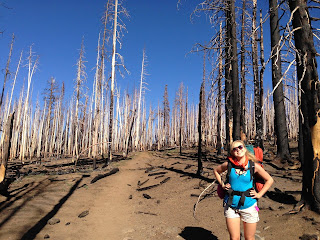One of my closest experiences with wildfire was in the Three Sisters Wilderness while on a backpacking trip with some friends. During the planning of our expedition I had read that a large wildfire had recently moved through the area, but since it would be my first time in central Oregon I really had no idea what to expect from the landscape. While the drive along highway 20 gave me some clues as to the extent of the fire, it was a whole new world when I finally put my boots to the trail.

My first reaction to the death on the landscape was that we were about to walk through a moonscape. There was ash and grey regolith loosely dusted across the entire ground surface, waiting for any light winds to catch and spread throughout the dead forest. Tree life had been completely removed from the area by fire -- only blackened spires remained as monument to the forest that had once lived there. Trail navigation became extremely difficult in areas with large ash deposits. Several times we had to double back or find a new stream crossing that may or may not have been officially on the trail.
Spirits remained high despite the hellish landscape. Perfect weather and the mountainous horizon pushed us through the burned area until we found a mountain meadow over top of a ridge that the fire had spared. Conditions for fire spread must have been nearly ideal in order to create a high severity burn on such a large swath of land. It appears that our meadow campground survived due to topographic shielding and high moisture in the area.

Interesting description of the fire in the Sister Wilderness. You used some descriptive words: "hellish", "moonscape" to convey your experience. While accurate to your experience and for maybe that moment in time I wonder what you description would be if you would return to the area 20 or more years later.
ReplyDeleteI am fortunate to work in a wilderness area were 250,000 acres burned in the 1988 Yellowstone fires. I would write a different description of the effects of fire for this area. I would describe how the fire had cleared away the decedent lodgepole forest that was choking out the vegetation essential for forage for wildlife. How fire had cleared away the forest that allows me today to see the magnificent views that surround me of allows me to see the grizzly bear on the next ridge that would otherwise been obscured by the forest.
Hi Ryan, I went for a hike this past summer throught the Pole Creek Fire that burned in the summer of 2012(the area I was in was located up Three Creeks Road, heading south out from Sisters) . The ground was almost entirely covered with fireweed(Chamerion angustifolium), and provided the most beautiful contrast to the scared and charcoaled trunks left behind. Fireweed is a pioneer species in fire burned areas, the plant itself provides browse for deer and are great for native pollinators. Its amazing how hot the Pole Creek Fire burned, I'm curious if it had any effect to the top layer of the soil... I know some areas of our forests are beetle-kill lodgepole areas, I also wonder if there were any stands of beetle-kill in the area that contributed to the fuel load and moisture content of such fuel. From your photos, it looks possible that we were in similar areas?
ReplyDelete